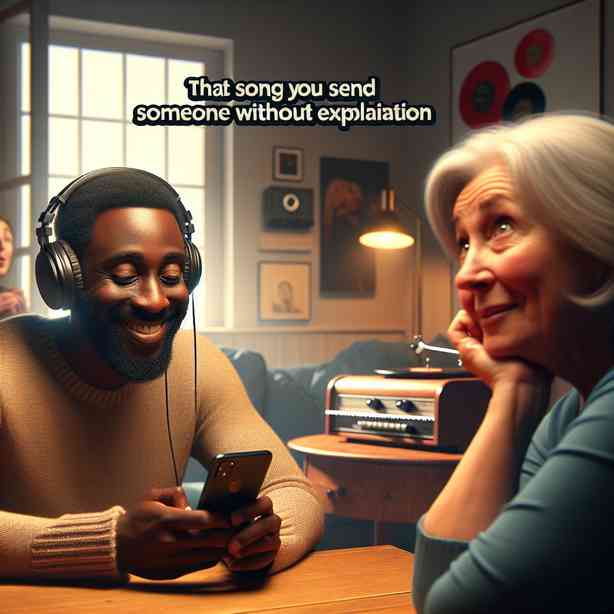
In the digital age, music has become a universal language that transcends barriers and connects individuals on a deeply emotional level. The phenomenon of sending songs to someone without a clear explanation has surfaced as a unique form of communication. Often, a single track can encapsulate emotions and sentiments that words alone might struggle to convey. This practice has grown, particularly through social media platforms and messaging apps, where users share songs with friends, family, or significant others, leaving the interpretation open to the recipient.
The motivations behind sending a song without explanation can vary widely. Sometimes, it’s a way to express feelings that are too complex or vulnerable to articulate in words. A carefully chosen song can reveal inner thoughts about love, loss, joy, or nostalgia—emotions we might hesitate to voice directly. It can serve as an indirect way to say, “I understand what you’re going through” or “I feel this way about you.” It allows the sender to communicate depth without the pressure of a face-to-face discussion or the intricacies of spoken language.
Moreover, music has a profound ability to evoke memories and imagery. When a song is sent without explanation, it invites the recipient to engage with it on a personal level. The person receiving the track might recall a shared moment or a specific experience related to that song, sparking a powerful response. This can lead to meaningful conversations or reflections, enriching the connection between the individuals involved. For example, sending a song that was playing during a significant time in their relationship can reignite a shared bond and evoke beautiful memories.
Additionally, the act of sharing music creates a sense of intimacy. It invites vulnerability, showcasing trust in the receiver’s ability to understand the sentiment behind the song. This can be especially significant in romantic relationships, where partners often feel compelled to find ways to express their emotions. Music serves as a facilitator for this exchange, as it often carries an emotional weight that words may lack. A simple song can harbor an immense amount of unspoken sentiment, creating an avenue for recipients to feel understood, validated, or even inspired.
In many instances, sending a song without context can also serve as a playful gesture. It encourages curiosity and opens a playful dialogue about musical tastes and interpretations. Recipients might find themselves asking, “Why did you send me this song?” This can lead to discussions that explore preferences and the influences of various genres. It allows both individuals to bond over music, sharing more about their tastes and possibly discovering songs that resonate with them.
Focusing on the essence of the song itself, the lyrical content, melody, or genre can create a multi-faceted experience for the recipient. Each song brings its unique identity, influenced by cultural and personal contexts. For instance, a classic rock song might evoke feelings of rebellion and nostalgia, while an indie track might inspire feelings of introspection or yearning. The variety in music allows senders to convey different messages or emotions. This richness can sometimes foster discussions on interpretations and personal meaning, leading to a deeper understanding of one another.
Social media platforms have also revolutionized this practice. With streaming services readily available, sharing music has never been easier. A song can be sent with just a click, and the act itself has become a form of creativity. Curating playlists for friends or sharing a favorite song can show thoughtfulness and genuine affection. It’s a modern method of saying, “I thought of you when I heard this,” or “This resonates with my feelings about you.” The digital landscape thus enhances the emotional tapestry woven through the act of sharing music.
Furthermore, it’s important to consider the impact of music on mental well-being. Studies have shown that music can significantly influence emotions and moods. Sending a song that uplifts can serve as encouragement during difficult times, while mournful melodies can validate feelings of sadness or grief. By choosing songs thoughtfully, senders can provide emotional support, acting as a reminder that they are not alone in their experiences. This reinforces the significance of the connection and the bond shared between sender and recipient.
As we navigate relationships—whether friendships, familial ties, or romantic partnerships—music acts as a shared experience, a way to bond over shared tastes and emotions. The collective experience of music listening can foster community and understanding. The song sent without explanation can symbolize a gesture of solidarity or empathy. It indicates that the sender acknowledges the recipient’s feelings and desires to reach out, even if indirectly.
In essence, the practice of sending a song without explanation goes beyond mere social interaction; it encapsulates the complexities of human relationships and communication. It showcases the profound ability of music to bridge gaps and convey sentiments that might otherwise remain unspoken. As we continue to explore the depth of emotions and connections through this medium, let us celebrate the art of sending songs, recognizing the unique power they hold in our lives.


